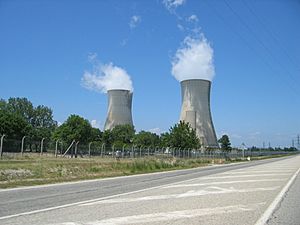Tricastin nuclear power plant facts for kids
The Tricastin nuclear power plant is a large facility in France. It makes electricity using nuclear energy. It has four big machines called reactors. Each reactor can produce 915 megawatts (MW) of power. This means the whole plant can make a total of 3.6 terawatts (TW) of electricity.
The plant is located next to the River Rhône. It is about halfway between the cities of Valence-sur-Rhône and Avignon. Construction of the plant started in 1974 and finished in 1981. The first reactors began making power in 1980.
Contents
What is a Nuclear Power Plant?
A nuclear power plant uses a process called nuclear fission to create heat. This heat boils water to make steam. The steam then spins large turbines, which are like big fans. These turbines are connected to generators that produce electricity. This electricity is then sent to homes and businesses.
Safety and Incidents at Tricastin
Over the years, there have been some concerns and small incidents at the Tricastin plant. Safety is very important at nuclear power plants. Experts regularly check to make sure everything is working correctly.
Cooling Systems and Earthquakes
In 2002, the French control authority, which oversees nuclear safety, pointed out a concern. They said that some of the plant's cooling systems might not work as well as needed if there was a strong earthquake.
Firefighter Training Concerns
A study in 2004 looked at how quickly firefighters could control a fire at the plant. The study found that it took them about 37 minutes to get a fire under control. This was thought to be too long. The report suggested that more training was needed for the firefighters.
Water Temperature Limits
In 2003, the temperature of the water in a canal next to the plant became too high. The water temperature was above the allowed limit for more than 44 hours. The maximum allowed temperature was 27 degrees Celsius (°C), but the water reached 28.8 °C.
Uranium Spill in 2008
Between July 7 and July 8, 2008, a liquid containing Uranium spilled at the site. This happened during cleaning work. About 75 kilograms (kg) of the liquid reached nearby rivers. The total amount spilled was about 250 kg. This incident was classified as a level 1 event on the International Nuclear Event Scale. This scale goes from 0 to 7, with 7 being the most serious.
After the spill, French authorities took action. They banned people from using water from the affected rivers for drinking or for watering crops. Swimming, water sports, and fishing were also not allowed in those rivers. Measurements taken three days later showed some radiation levels that were higher than expected. This led investigators to believe that similar small spills might have happened before without being reported. The company involved in the uranium work was temporarily closed.
Radioactive Particles Exposure
Also in July 2008, about 100 employees were exposed to small radioactive particles. This happened when the particles escaped from a pipe in a reactor that had been turned off for maintenance.
Broken Valve Detection
On August 21, 2008, workers found a broken valve while replacing a pipe. This broken valve meant that small amounts of radioactive uranium could sometimes leak into the environment around the plant. A study was started to find out exactly how much uranium might have leaked over time. The plant operators estimated it to be about 250 grams per year.
Images for kids





